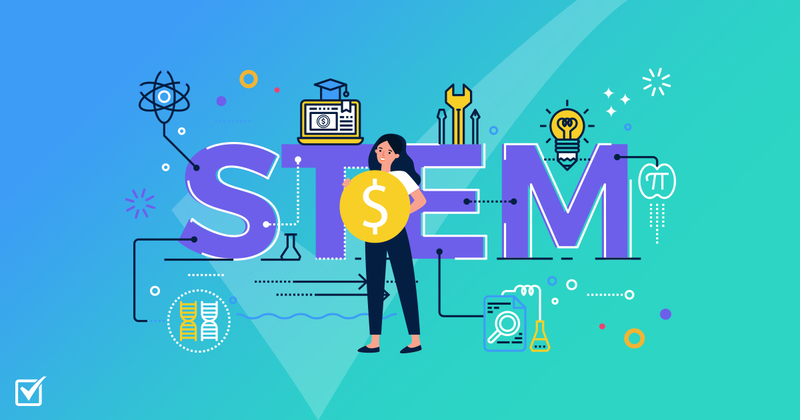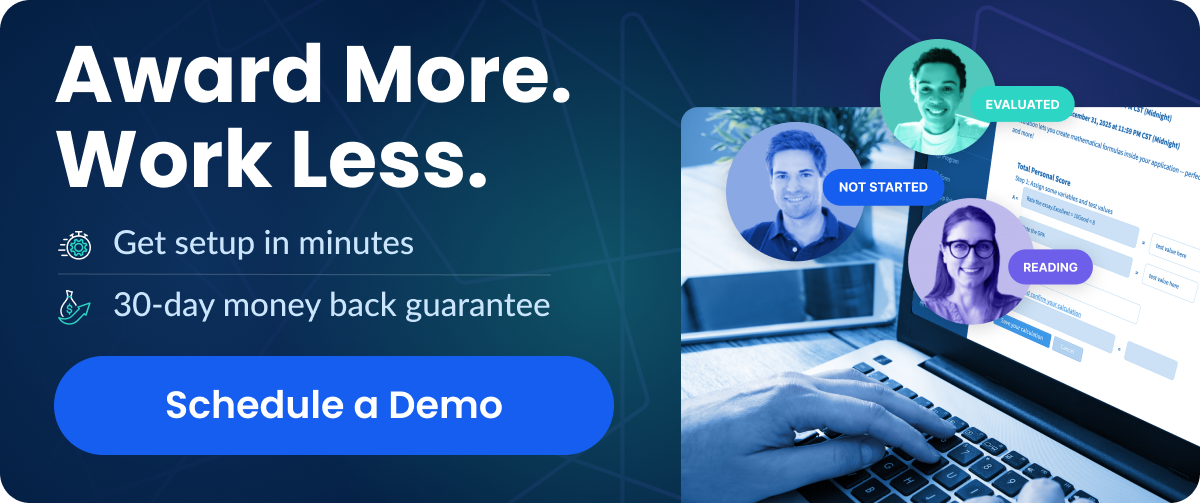How to Manage Diversity in STEM Scholarships
Better application management of scholarships, grants, awards, and more.

How to Manage Diversity in STEM Scholarships
It may not seem like the most exciting subject in the world, but we need to have a chat about diversity in STEM scholarships. How can we manage diversity with these types of scholarships? Why is diversity in them so important? We’ll cover all this and more below!
What’s the Big Deal? Managing Diversity in STEM Scholarships
Science, technology, engineering and mathematics aka STEM fields - These are often viewed as boring domains filled with stuffy academics doing serious research. Behind the white lab coats and thick textbooks however, lies a vibrant world brimming with creativity, innovation...and yes, even fun! The diverse perspectives and ideas that people from all backgrounds bring enhances this spirit of imagination inherent in science, technology, engineering and math.
This is why diversity in STEM scholarships is so critical - it allows students from all walks of life to access educational opportunities that fuel innovation. Whether it’s the daughter of a fisherman coding climate solutions or a third generation son of immigrants pioneering new spacecraft propulsion systems, diversity unlocks a wealth of untapped potential.
Let’s delve into curating scholarship programs where all bright young minds have room to blossom!
The Current Landscape of STEM Scholarships
To understand how we can improve managing diversity in STEM scholarships, we must first examine the current state of affairs. A multitude of programs exist to support underrepresented groups pursuing STEM education, but there is still progress to be made.
Overview of Existing Diversity Initiatives
Many organizations have launched scholarship initiatives targeting women, minorities, first-generation students, and other underrepresented demographics. For example, the United Negro College Fund provides scholarships to African American students, while organizations like The American Association of University Women (AAUW) focus on advocating for gender representation in academia. Industry leaders like Intel and Microsoft also fund diversity scholarships to improve representation in tech fields.
The National Science Foundation aims to promote women and minorities in STEM through various funding programs. Government-sponsored initiatives also increase access, like the Department of Education’s Gaining Early Awareness and Readiness for Undergraduate Programs (GEAR UP). Overall, between federal and private sector efforts, there are more than 170 STEM scholarship programs according to Scholarships 360.
Identifying Gaps in Representation
Despite these efforts, females, African Americans, Hispanics, Native Americans, and other minority groups still lag significantly behind Asian and white men in earning STEM degrees. Though women earn 50.7% of undergraduate degrees overall, they receive just 20% of computer science degrees and 22% of engineering degrees. Overall, underrepresented minorities earn around 26% of bachelor’s degrees in science and engineering fields.
Much work remains to close gaps like these in terms of representation across STEM disciplines. More targeted outreach and support is needed. Proactive efforts must continue addressing why minorities leave STEM majors at higher rates as well.
Highlighting the Benefits of Diverse Perspectives
Homogeneous environments diminish productivity - diversity enhances critical thinking and problem solving. Varied backgrounds bring different perspectives, enhancing analytical capabilities in STEM where innovation matters most.
Since many challenges STEM fields tackle relate to social issues, ranging from the environment to public health crises, diversity enables insights only lived experiences can provide. Integrating knowledge from underrepresented groups leads to advancements better calibrated to serve society’s true needs.
Barriers to Diversity in STEM Scholarships
A multitude of obstacles deter underrepresented groups from pursuing and succeeding in STEM education. These barriers manifest in various socioeconomic, cultural, and institutional challenges. Identifying and addressing these barriers is key to diversifying STEM scholarships.
Socioeconomic Factors
Financial limitations pose significant hardships, especially for minority and first-generation college students. STEM degrees often necessitate unpaid internships or research opportunities only affordable for students without working obligations. Additionally, supplementary academic resources many take for granted - like textbooks, laptops, and prep materials - accumulate substantial unpaid bills for budget-strapped scholars.
Gender Disparities
Stereotypes dissuading women from technical roles still prevail, portraying STEM as masculine domains. Without sufficient visibility of female scientist and engineer role models, harmful assumptions go unchallenged. Gender achievement gaps also emerge early, showing girls express less confidence in STEM abilities by middle school - making outreach imperative before self-doubt sets in.
Underrepresentation of Minority Groups
African Americans, Hispanics, Native Americans and other minority groups remain critically underrepresented. Without built-in support systems, these students often feel isolated tracking toward STEM degrees, further discouraging sustained interest.
Strategies for Inclusive STEM Scholarship Programs
Implementing thoughtful strategies that dismantle barriers is imperative for diversifying STEM scholarships. Various structural, outreach, and support tactics can cultivate representation if executed intentionally.
Establishing Clear Diversity Goals
Scholarship programs must set well-defined inclusion objectives regarding demographics, metrics, and targeted diversity growth. Quantifiable diversity goals enable oversight mechanisms gauging progress. They also reinforce accountability ensuring initiatives designed to reach underrepresented groups are thoughtful and data-driven when addressing gaps.
Collaborating with Underrepresented Communities
Authentic engagement with marginalized communities identifies effective channels for outreach while surfacing unique pain points in need of redress. Working cooperatively, scholarships can pivot efforts reactively based on real-time feedback directly from underrepresented groups. This input should inform scholarship parameters, messaging strategies, and funding criteria.
Implementing Outreach and Awareness Campaigns
Once armed with insights from disadvantaged communities, scholarships should launch information sessions, school visits, community enrollment drives and other campaigns in overlooked regions. Raising visibility around opportunities and dismantling assumptions about STEM accessibility are paramount to spurring engagement. Outreach should target students at various learning levels to secure pipelines early.
Creating Supportive Networks and Mentorship Programs
Underrepresented students need communities reinforcing their ambitions. Scholarships should enable networking and mentorship initiatives pairing scholars with inspirational role models possessing relatable backgrounds. Developing these supportive communities fortifies students as they navigate unfamiliar environments, providing solid foundations to stand upon while tracking toward STEM careers.
Share Case Studies of Successful Inclusion in STEM Scholarships
Highlighting programs with proven track records and showcasing noteworthy success stories can help encourage underrepresented groups to apply for financial aid. Sharing these types of stories of inclusive scholarships is a wonderful public display of what is possible for everyone - regardless of their race or socioeconomic background.
Overcoming Unconscious Bias in Scholarship Selection
Even well-intentioned selection committees can harbor unconscious biases influencing applicant evaluations. Research shows resumes with ethnic names often receive lower scores despite identical qualifications. Mitigating these ingrained biases is paramount for equitable assessment.
Training Scholarship Committees
Providing selection panelists bias-reducing training raises awareness of prejudicial pitfalls, arming raters to self-correct inclinations questioning applicants’ aptitude based on race, gender, or socioeconomic background. Training also cultivates mindsets embracing diversity’s benefits, realigning values to see candidates’ uniqueness as accretive edge cases.
Implementing Blind Application Reviews
Concealing applicant demographic details, including name and gender, enables evaluators to objectively judge candidates solely based on experiences, accomplishments and passions conveyed through written submissions and interviews. Blind evaluations based on merit and potential bypass biases tied to other ethnic, cultural and gender signaling.
Fostering Fair Evaluation Criteria
Rubrics should outline inclusive criteria focused on assessing grit, curiosity, and growth mindsets indicative of STEM excellence. Holistic reviews valuing rich life experiences also mitigates assumptions tied to ethnic, gender or cultural stereotypes.
Crafting inclusive assessment frameworks focused purely on merit and potential can help panelists see past societal noise and recognize promising talent regardless of background. Eliminating biases in selection empowers scholarships to unlock more diverse innovators.
The Role of Technology in Promoting Diversity
Advancements in technology provide new vehicles to connect with overlooked talent and promote inclusion through continuous improvement powered by data.
Leveraging Tech for Outreach and Recruitment
Digital channels have unmatched ability spreading scholarship awareness, enabling both broad outreach and precision targeting of marginalized groups. Tech also eases application burdens, expanding access. And automated eligibility tools can actively identify and nudge promising yet hesitant potential applicants.
Online Platforms for Networking and Support
Private online communities allow scholars to find mentors, join campus groups, and band together before even setting foot on campus, establishing early support systems vital to retention. YouTube tutorials covering overlooked basics – like the FAFSA process or campus life – further demystify the college journey. And always-available mobile forums give underrepresented students ongoing guidance.
Tech Solutions for Monitoring and Evaluating Diversity Metrics
Analytics dashboards make tracking program diversity seamless while machine learning algorithms objectively monitor for biases hidden in current selection processes. Tech provides continuous insights so leaders can course correct initiatives and double down on what works. And automated reporting keeps stakeholders updated on progress toward inclusion KPIs.
Realizing the Dream of an Inclusive STEM Future
The strategies outlined here - from setting diversity goals to leveraging technology - aim to improve access to STEM education through more representative scholarship programs. But achieving sustainable progress requires persistent commitment from all stakeholders.
Through advocating for policy reforms, encouraging industry partnerships, and institutionalizing inclusive mindsets, we can gradually chip away at factors inhibiting diversity. Although long-term change won’t happen overnight, even incremental improvements inch us toward a more innovative and STEM landscape.
If managing diversity in STEM scholarships feels overwhelming, SmarterSelect software helps streamline oversight while amplifying inclusion. Schedule a demo today to learn more about what we can do for your program!
You might also like
There are no related posts
SUBSCRIBE TO OUR BLOG!
CATEGORIES
- Online Application Software (49)
- Features (33)
- Scholarship software (29)
- scholarship management (21)
- Scholarship Management Software (20)
- scholarship program (15)
- Grant software (14)
- program management (11)
- Award software (10)
- application management (10)
- application management systems (9)
- scholarships (9)
- Corporate scholarships (8)
- Grant Management Software (8)
- Feature Update (6)
- Grantmaking (6)
- Scholarship Funds (6)
- SmarterSelect (6)
- app tree (6)
- grants (6)
- navigation (6)
- Grant compliance (4)
- scholarship program manager (4)
- Conferences (3)
- Grant compliance and reporting (3)
- Product Feature (3)
- grant managers (3)
- scholarship application templates (3)
- Association Software (2)
- Awards management platforms (2)
- Customer satisfaction (2)
- Grant management (2)
- Grant reporting (2)
- Scholarship marketing (2)
- scholarship award letter (2)
- scholarship program template (2)
- scholarship rejection letter (2)
- Awards management software (1)
- Grant lifecycle (1)
- Handling incomplete applications (1)
- How to automate scholarship program communication (1)
- Inspiring employee recognition awards (1)
- International scholarships (1)
- Mathematics scholarships (1)
- Merit based scholarships (1)
- Need based scholarships (1)
- Reverse scholarship (1)
- STEM scholarships (1)
- Scholarship administration (1)
- Scholarship application errors (1)
- Scholarship application management (1)
- Scholarship award management (1)
- Scholarship communication (1)
- Scholarship cycles (1)
- Scholarship disbursement process (1)
- Scholarship fund diversification (1)
- Scholarship fund management (1)
- Scholarship funding (1)
- Scholarship renewal (1)
- Scholarship tracking (1)
- Support (1)
- Technology scholarships (1)
- Wizehive pricing (1)
- accept payment (1)
- email productivity (1)
- grant makers (1)
- grantmaking best practices (1)
- payment (1)
- paypal (1)
- post award grant management (1)
- program managers (1)
- scholarship agreement (1)
- scholarship applicant complaints (1)
- scholarship applicant's issues (1)
- scholarship rejection letter template (1)
- wizehire alternative (1)
- wizehive review (1)



